2 August 2024
Global Market Outlook
Global Market Outlook
Rate cuts: Winners and losers
Fed rate cuts aimed at supporting growth rather than fighting inflation back our preference for equities over cash and other major asset classes. The US growth outlook remains the key risk to monitor.
US equities may face greater volatility given optimistic investor positioning, but this short-term risk does not preclude long-term outperformance. We would buy on dips.
Cash would be most at risk from a Fed rate cutting cycle. We would instead lock in opportunities in bonds to earn income over a longer period. Gold, which we see as a core holding, should also benefit from lower interest rates and bond yields.
Biden drops out: Is it a game changer?
What are the changes to your opportunistic ideas?
Is your quantitative model still bullish on equities?
Strategy
Investment strategy and key themes
|
|
||||
|

Our top preferences
Foundation Allocations
- OW Global equities
- In equities: US
- In bonds: EM USD bonds
Opportunistic Allocations
Equity BUY ideas
- US technology sector
- US comms. services sector
- India large cap equities
- China non-financial divi SOEs
- Japanese banks
- US major banks
Bond BUY ideas
- China USD bonds
- Europe govt. bonds (FX-hedged)
- INR local currency bonds
- US Agency MBS
12m FX views
- Bullish bias on USD
Rate cuts: Winners and losers
- Fed rate cuts aimed at supporting growth rather than fighting inflation back our preference for equities over cash and other major asset classes. The US growth outlook remains the key risk to monitor.
- US equities face greater volatility given optimistic investor positioning, but this short-term risk does not preclude long-term outperformance. We would buy on dips.
- Cash would be most at risk from a Fed rate cutting cycle. We would instead lock in opportunities in bonds to earn income over a longer period. Gold should benefit from lower interest rates and bond yields.
A slow start to H2
Risky assets have had a relatively muted start to H2 24. While they initially rose, global equities subsequently fell back from their recent peak after US authorities raised the possibility of renewed restrictions on semiconductor trade with China. US bond yields, however, are unambiguously lower over the past month as the narrative has moved firmly in favour of lower Fed rates this year.
Fed rate cut narrative gains momentum
While European central banks have taken the lead in cutting rates, the market focus is now on when the Fed will start doing likewise. With recent US inflation releases having largely been in line or below expectations, we now expect the Fed to cut rates twice in 2024 and twice more in H1 25. This is one key assumption behind our ‘soft-landing’ outlook for the US economy, which involves slower, but still positive, growth underpinned by Fed rate cuts.
The ongoing US election campaign remains another focus. Polling still favours a Trump win, even after Harris replaced Biden as the Democrat candidate. This has kept markets focussed on potential ‘Trump trades’, such as domestic stimulus winners (eg, US financial sector equities), and the potential risks from his proposed tariffs. However, we are still 3 months away from the election itself. The composition of the House is also a much closer call and one that is likely to define how much policy leeway exists for the future US President, particularly on the domestic policy agenda.
Fig. 1 US equities Overweight well supported by valuation and market breadth
Positive scores indicate preference for equities

US and Indian equities to lead
We continue to expect equities to outperform cash and other major asset classes, but this outperformance is likely to come with more volatility than we experienced in H1 24.
Excessive optimistic investor positioning remains one key challenge, particularly for US equites. Our own proprietary indicator’s warning signal has abated, but other data sources suggest broader measures of investor positioning remain excessively optimistic and cash levels are relatively low. This creates conditions for pullbacks and we have trimmed our US equity Overweight marginally.
Pullbacks driven by positioning, though, tend to be short-term in nature and, hence, we would view any such pullback in US equities as an attractive buy-on-dip opportunity. We remain Overweight US equities on a 6-12-month horizon in foundation allocations as we believe positive US growth should support continued earnings growth. We see a relatively more muted outlook for Euro area equities – on a softer growth outlook – and Japanese equities – on still-weak technicals. We also see attractive ideas for opportunistic allocations in, among others, US and Japanese banks and the US technology and communication services sectors.
In Asia ex-Japan, we remain Overweight Indian equities. Valuations are undoubtedly high, but we believe the growth outlook and a focus on large-cap equities help mitigate this. Chinese equities, though, remain a core holding on the lack of new catalysts. In opportunistic allocations, we favour large-cap Indian equities and high-dividend-paying non-financial Chinese state-owned enterprises.
Fed cuts to lower bond yields
Expectations of Fed interest rate cuts remain a key driver of bond yields as the Fed rate cut narrative gains momentum. This reinforces our view that bonds today offer opportunities to lock in yields for a longer period. Indeed, this remains one key reason why we prefer high quality bonds over cash given shorter-term yields on cash deposits are likely to decline as the Fed cuts rates.
Fig. 2 Yield premiums on corporate bonds over Treasuries currently offer relatively little value
Corporate and EM bond spreads vs. history
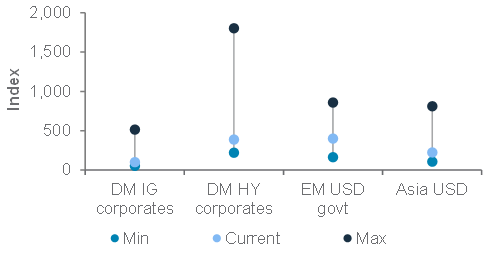
While locking in the yield is a key opportunity today, in our view, finding value in corporate or Emerging Market (EM) bonds remains much harder. We believe EM USD government bonds are one pocket of value in foundation allocations. Stress does still exist in several individual markets, but we believe the yield premium over US government bonds more than compensates for the idiosyncratic risks.
We also see attractive ideas for opportunistic allocations in US agency mortgage-backed securities, (FX-hedged) Euro area government bonds, China USD bonds and INR local bonds.
A rebound in FX volatility
One of the most notable events in markets over the past month was the rebound higher in currency market volatility. Suspected policy intervention pushed USD/JPY sharply lower, a move we believe can extend significantly further below 150 on strong momentum and tightening BoJ policy. This coincided with a sharp move lower in the USD index.
However, we do not expect this volatility to break out of the recent ranges for now. This means that the move lower in the USD is likely to extend over a 1-3-month horizon as Fed rate cut expectations gather pace, but this is likely to reverse over a longer 6-12-month horizon as non-US central banks continue to cut rates. Therefore, we would view rebounds in major currencies, such as the EUR, as an opportunity to sell, with the JPY the only exception given the contrasting BoJ policy.
Goldilocks for gold
We continue to see gold as a solid core holding. We have noted before that our constructive view is based on a tight demand/supply balance and our expectations of lower bond yields. Recent data continues to support these arguments, especially with Fed rate cut expectations on the rise.
Our positive view notwithstanding, we see gold as a core holding as the magnitude of gains may struggle to beat those on equities, given gold’s lack of yield.
Foundation asset allocation models
The Foundation and Foundation+ models are allocations that you can use as the starting point for building a diversified investment portfolio. The Foundation model showcases a set of allocations focusing on traditional asset classes that are accessible to most investors, while the Foundation+ model includes allocations to private assets that may be accessible to investors in some jurisdictions, but not others.
Fig. 3 Foundation asset allocation for a balanced risk profile

Fig. 4 Foundation+ asset allocation for a balanced risk profile
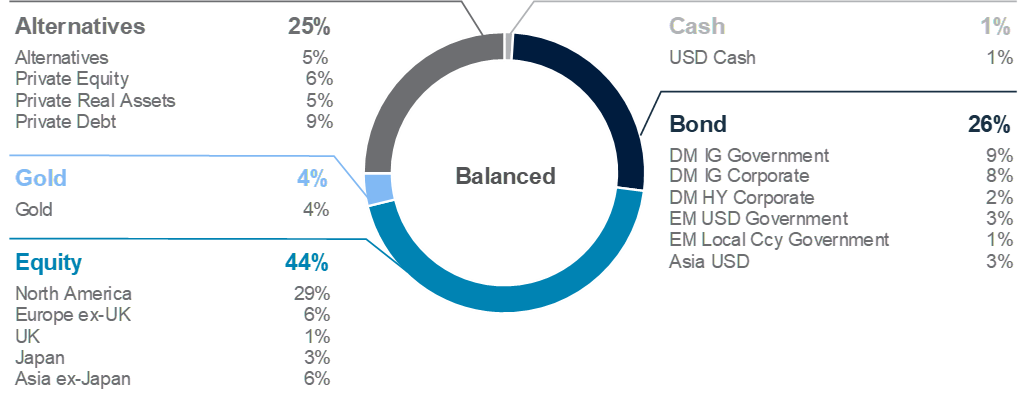
Fig. 5 Multi-asset income allocation for a moderate risk profile

Foundation: Our tactical asset allocation views
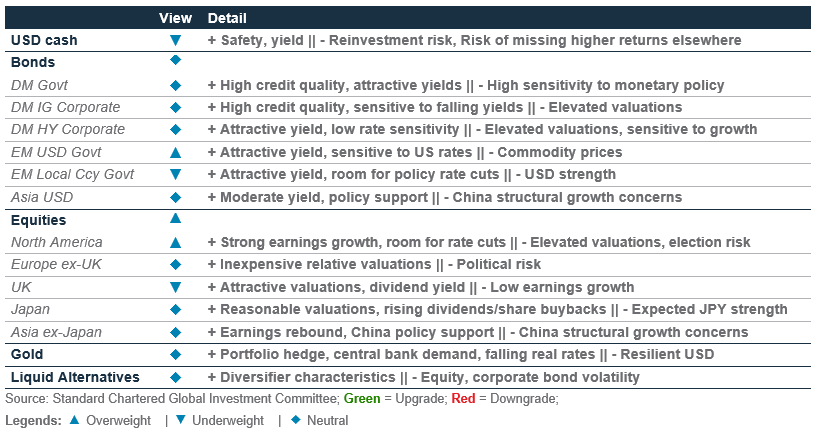
Fig. 6 Performance of our Foundation Allocations*
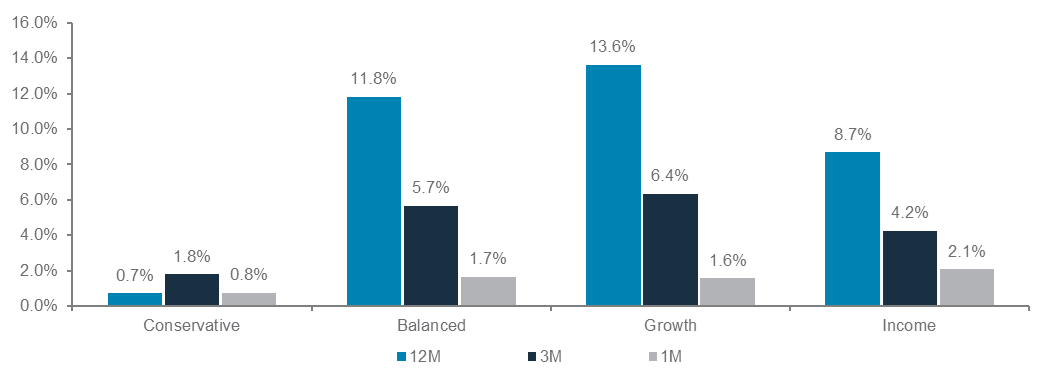
*12-month performance data from 1 August 2023 to 1 August 2024, 3-month performance from 1 May 2024 to 1 August 2024, 1-month performance from 1 July 2024 to 1 August 2024; sourced on 2 August.
Perspectives on key client questions
|
|
||||
Biden drops out: Is it a game changer?
In a dramatic twist, US President Joe Biden ended his re-election bid, endorsing Vice President Kamala Harris as the Democrat presidential candidate. This sent ripples through financial markets, leaving investors scrambling to gauge whether it boosts or diminishes Donald Trump’s chances of reclaiming the White House and a Congressional clean sweep. In the wake of Biden’s announcement, the ‘Trump trade’ has re-emerged, sparking gains in small cap, financial and energy sector equities as investors start to price a potential Trump victory.
Polls suggest narrow margins in key swing states, which make the outcome highly unpredictable – see the chart on the next page for implied Republican victory probabilities. To navigate this uncertainty, we examine four possible election outcomes, the policy implications, and the sectors and financial assets that are expected to emerge as winners or losers, based on the outcome of the elections.
A Republican (Trump) clean sweep scenario: Bullish, but with caveats
A Republican sweep of the White House and Congress would bring significant policy changes, offering Trump legislative freedom to implement his stated policies. These include further cuts to corporate taxes and making permanent individual tax cuts, which would boost corporate profits and consumer spending. More business-friendly regulations may also be introduced, including the deregulation of the energy and finance sectors and the reversal of Biden’s environmental policies, which have weighed on traditional sectors.
However, a Republican clean sweep would also entail more aggressive tariffs, tighter immigration policies and foreign policy shifts that might offset the benefits of tax cuts and looser regulations. For instance, the extension of tax cuts could widen the fiscal deficit, risking higher bonds yields and a weaker dollar. Trump’s proposal of trade tariffs is likely to support the dollar and dampen risk sentiment. Meanwhile, stricter immigration controls could curb labour supply, driving up inflation and ultimately weighing on consumer demand. Lastly, reduced US military engagement abroad

Fig. 7 A Republican clean sweep is arguably the most market-friendly election outcome
2024 US election scenarios, policy implications and market impact
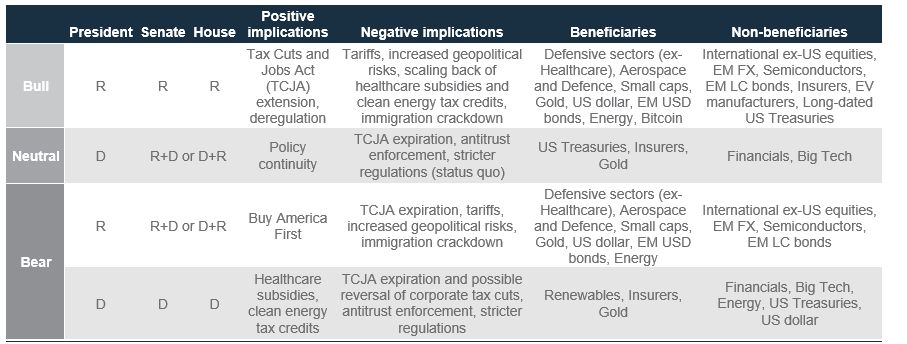
would likely aggravate tensions in several geopolitical hotspots, risking an increase in market volatility.
Trump + Divided Congress: Negative mostly for equities
While a Republican clean sweep promises some good (tax cuts, looser regulations) along with the bad (tariffs), a Trump presidency with a divided Congress may entail mostly negative implications for equity markets. This is potentially the worst scenario for financial markets. While Trump could rely on executive orders to bypass legislative gridlock and effect changes in trade and immigration policies, the extension of tax cuts would require the involvement of Congress. With the odds of a Republican clean sweep falling significantly following the stepping down of President Biden, it is likely markets will increasingly focus on tariff trades, as the scenario of a Trump victory with a divided Congress marks a significant departure from the status quo.
Fig. 8 Republican clean sweep odds have declined
Betting market implied odds of a Republican victory
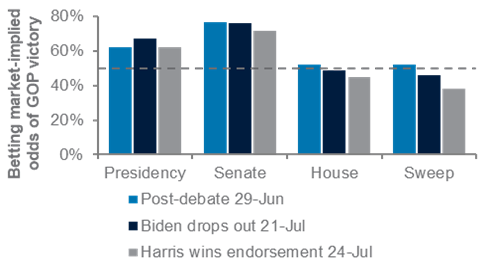
To identify the assets that could serve as a hedge against the threat of tariffs, we analysed the performance of various assets surrounding tariffs-related news headlines back in 2018/19. We found that defensive equity sectors, such as utilities and consumer staples, along with high-grade bonds and gold, tend to perform well in the lead up to the peak in tariff-related news headline count. Conversely, EM assets, particularly China’s equities and the CNH, unsurprisingly tend to bear the brunt of Trump’s tariff threats. (Fig10)
Fig. 9 EM assets, oil, energy sector hurt by a rise in tariffs-related tensions during 2018 and 2019
Bloomberg story count of trade tariffs
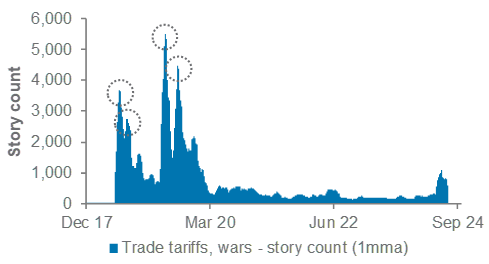
A Democrat President and a divided Congress: status quo
A Democrat president in the White House with a gridlocked Congress would likely maintain the status quo, with Republicans continuing to stymie significant new policies. This policy gridlock scenario appears the most neutral for markets in the short-to-medium term, in our view.
A Democratic clean sweep: Least likely, Negative equities
Like a Republican clean sweep, a blue wave would bring about both positive and negative policy implications, but the near-term impact on financial markets would likely be more negative. Individual tax cuts would be allowed to expire, corporate tax cuts potentially reversed, and stricter regulations and antitrust measures could be introduced, impacting the financial, technology and energy sectors. In contrast, immigration issues would likely take the backseat and the geopolitical landscape would likely be more predictable. However, the implication of higher taxes would ultimately weigh on sentiment, making this election outcome potentially one of the worst for financial markets short term.
Fig. 10 Defensive equity sectors, high-grade bonds and gold outperformed when threats of tariffs intensified
Returns 22 trading days prior to peak in tariff news count
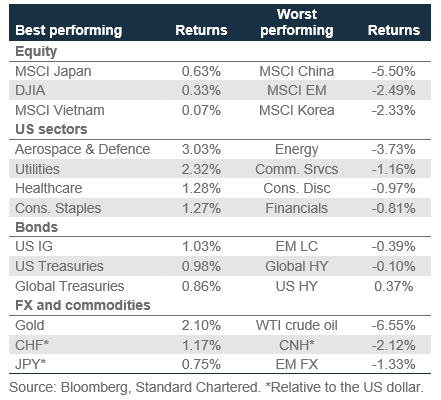
Gold to benefit, regardless of the election outcome
As rhetoric on tariffs intensify in the lead up to the election day in November, defensive equity sectors such as utilities, staples and healthcare, high-grade bonds and gold are likely to benefit. Gold stands to benefit regardless of the election outcome as Trump’s policies would likely be inflationary in nature and leading to a rise in geopolitical tensions, benefitting gold. The US fiscal deficit is also set to increase, regardless of which party is in power, and the macro environment remains favourable, with the Fed expected to soon cut rates and global central bank gold purchases set to continue. From an investor positioning perspective, gold, staples and healthcare also look less stretched near term relative to utilities, where investors may have pre-positioned themselves for the sector to benefit from rate cuts later in the year.
Macro overview – at a glance
Our macroeconomic outlook and key questions
|
Key themes
Fed rate cuts loom: The US economy, which has led the post-COVID recovery in global growth, is slowing. Inflation is cooling, including in the crucial services and housing sectors, while unemployment is rising. We believe this backdrop will enable the Fed to cut rates twice this year, starting in September, as it shifts focus towards achieving an economic soft-landing. Risks: Delayed Fed policy easing could raise recession risks. Also, Middle East tensions could reignite inflation, while November’s US presidential election uncertainty could curb private investments and slow consumption.
ECB to cut further, BoJ to tighten further: We expect the ECB to cut rates twice more this year as inflation resumes its downtrend. Manufacturing continues to contract and high policy rates and tight fiscal policy are hurting business confidence. After July’s rate hike, the BoJ plans to taper bond purchases to partly reverse the JPY’s weakness that is hurting households.
China to ease policy further: At the Third Plenum, policymakers focused on long-term reforms and technological innovation, instead of providing large-scale stimulus. Nevertheless, we expect measured policy easing in H2, including cuts to bank reserve requirements and policy rates and targeted credit boost to support growth around the 5% target.
Key chart
The Fed is likely to cut its policy rate twice this year as it shifts its focus towards supporting growth, as inflation cools and unemployment rises; other major central banks, except the BoJ, are also likely to cut rates to support growth.
Fig. 11 Fed policy likely too tight as inflation slows; BoJ only major bank likely to hike
Fed funds rate, US jobless rate, core PCE inflation; Market-implied 12m policy rate change*

Macro factors to watch
Fed policy pivot. The Fed has signalled it is close to easing policy. In our base scenario, we expect the Fed to cut rates twice this year and two more times in H1 25, helping the US economy achieve a soft-landing. Although the economy grew at a stronger-than-expected 2.8% annualised rate in Q2, aided by robust consumption, monetary policy is getting tighter. The Fed’s preferred inflation gauge (core PCE), at 2.6%, is below its end-2024 projection of 2.8% and well below the 23-year-high policy rate of 5.5%. Meanwhile, US jobless rate rose to 4.1% from a cycle low of 3.4%, job vacancy rate fell to a three-year low and the jobless rate for permanent job losers rose just short of a threshold that has historically signalled an imminent recession. An upturn in both the initial and continuing jobless claims in recent months raises the urgency for the Fed to cut rates. Meanwhile, the US presidential election race has tightened after Vice President Harris replaced President Biden as the Democrat candidate. This adds uncertainty, given the Democrats’ divergent policy path compared with that of Republican challenger Trump.
ECB to cut further. Although Euro area Q2 GDP growth remained resilient at 0.3% q/q, we see downside risks rising as the US and China economies, the region’s two biggest export markets, slow in the coming quarters. The services sector remains the primary driver of growth as lower inflation lifts disposable income. However, the region’s manufacturing sector continues to contract, fiscal policy (especially in Germany) remains tight and monetary policy has tightened as inflation cools. Therefore, we expect the ECB to cut rates twice more in H2 and another 50bps in H1 25 to support growth.
China’s measured policy easing. Slower-than-expected Q2 growth and falling bond yields have raised the urgency for Beijing to keep easing policy to support growth. The surprise cut in the main policy rate is likely to be followed by further cuts in bank reserve requirements, support for the housing market and more funding for local governments. A Trump presidency in the US is among the biggest risks over the next 6-12 months as the former president plans to impose a 60% tariff on imports from China. Beijing is likely to keep some policy space to counter any adverse post-election US policies.
Asset Classes
Bonds – at a glance
|
|
||||
Key themes
We are Neutral both rates (government bonds) and credit (corporate bonds). We retain a core holding (Neutral) on Developed Market (DM) Investment Grade (IG) government bonds. Softer-than-expected DM growth has prompted expectations that DM central banks would further adjust monetary policies looser towards the end of this year. We are adjusting our 3-month target for US 10-year government bonds 25bp lower to 4.00-4.25%.
Both DM IG and High Yield (HY) corporate bonds are core holdings (Neutral). Q2 corporate earnings released thus far have generally been strong and we believe the recent pullback in yield premiums has improved the risk-reward balance.
In Emerging Markets (EM), we retain an Overweight on EM USD government bonds. Relative value still looks attractive when compared with similar rated peers in the DM. We are Underweight EM local currency (LCY) government bonds. While EM bond yields could move in tandem with US government bonds lower, the EM currency outlook poses a risk amid surging geopolitical risk, especially in a scenario of a Republican sweep of the White House and Congress.
In Asia, we have core holding (Neutral) on Asia USD bonds due to a mixed economic backdrop across both the Greater China region and ex-China markets. Moreover, new rounds of monetary policy loosening by the PBoC and the details of India’s state budget support our preference for Asia HY over Asia IG bonds.
Key chart
EM USD government bonds offer an attractive pick-up in nominal yield when compared with EM LCY peers; improved fundamentals in DM corporate, led by IG issuers, support tighter bond yield premiums, in our view.
Fig. 12 Relative value of EM USD government bonds is attractive; DM corporate fundamentals, particularly IG issuers, remain strong
JPMorgan EMBI and GBI-EM nominal yield; US IG and HY upgrade/downgrade ratio (>1 represents upgrade outpace downgrade, vice versa)

Keep tactical buy on US agency mortgage-backed securities (MBS)
We believe MBS continues to offer an attractive yield pick-up over comparable US government bonds. The US residential housing market appears stable and we anticipate any prepayment risk to be largely contained ahead of the upcoming Fed pivot due to significant mortgage refinancing during the pandemic, when interest rates had fallen to exceptionally low levels.
Keep tactical buy on US agency mortgage-backed securities (MBS)
After cutting benchmark rates in July, we expect the PBoC to deliver more loosening to support the real economy. Onshore yields are likely to stay anchored, creating a favourable interest rate differential backdrop for offshore bonds. We retain our tactical buy on China USD bonds.
Keep tactical buy on Euro area government bonds (FX-hedged)
We retain our tactical buy on EUR government bonds (FX-hedged). After delivering the first rate cut, we anticipate the ECB to remain data-dependent while marching on its rate cut path. Additionally, with the French election risk now behind us, we believe French government bonds could rebound relative to their Euro area peers.
Keep tactical buy on INR bonds
Finally, we keep our tactical buy on INR bonds. We continue to believe the asset class offers attractive risk-reward given attractive yields and index-driven inflows against the backdrop of a largely stable INR (USD/INR forecast: 84).
Equity – at a glance
|
|
||||
|
|
||||
Key themes
We remain Overweight equities over bonds and cash, with US equities remaining our most preferred region. While volatility is likely to persist in the very near term, we do see this as a buying opportunity – US companies continue to demonstrate solid long-term growth in earnings, and the recent sector rotation is a strong sign of a ‘broadening-out’ in performance, which is healthy for the markets over the long term. We see Japan equities as a core holding (Neutral). The short-covering rally in the JPY against the USD following the Bank of Japan’s surprise rate hike is leading to short-term volatility in Japan equities. However, continued improvement in corporate governance is likely to sustain a medium-term positive re-rating in Japan equities.
We have a core holding (Neutral) view on Asia ex-Japan equities, but within the region, we remain Overweight Indian equities. The Indian budget shows policymakers are balancing the prioritisation of investment spending with the development of rural and lower-income segments of the economy, which should lead to more sustainable growth in India over the longer term. Taiwan and Korea equities are core holdings (Neutral), with tailwinds from the AI theme balanced by expensive valuations vs. history. We also see Chinese equities as a core holding (Neutral). Demand remains weak, and there was little from the Third Plenum as a market catalyst. We remain Underweight on ASEAN, which is overly defensive in an environment favouring high-beta stocks.
Euro area equities remains a core holding (Neutral), with cheap valuation offset by lacklustre performance in the economy. Lastly, we are Underweight UK equities, with subdued earnings growth, although the markets have taken the new government well.
Key chart
Equities in a sweet spot, with falling inflation, high margins.

Fig. 13 US equities’ earnings growth expectations continue to be the highest among developed markets, rising further in 2025; sector performance continues to broaden.
Earnings growth across key regions in 2024 and 2025; Sector returns
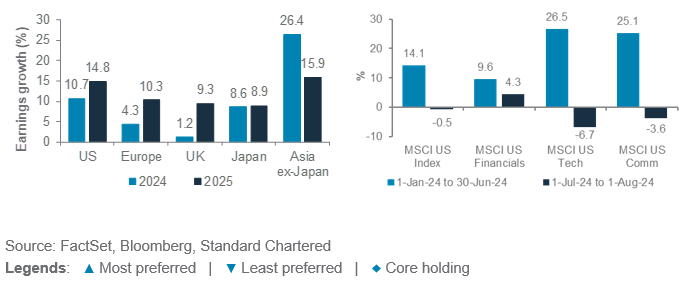
Buy the US on dips
We are Overweight US equities. We see a confluence of catalysts to support continued growth in the market. On the macro front, cooling inflation supports corporate margins. A potential Fed pivot towards rate cuts in the coming quarters should continue to support growth stocks by alleviating the impact on discounted future earnings. While there was a sell-off in the broader market at the start of H2, due to over-crowded positioning in the growth sectors, we see such dips as a buying opportunity, especially as performance is broadening out to non-growth sectors and Q2 24 earnings remain strong. Earnings are forecasted to grow by 10.7% in 2024, and 14.8% 2025 – well ahead of other developed markets.
We are Neutral on Japan equities. While we are positive on tailwinds, including improving shareholder returns and robust cash savings among local citizens, a strengthening JPY amid further normalisation in BoJ monetary policies, including tapering of bond purchases and rising interest rates, can act as a near-term headwind to Japan equities.
We have a core holding (Neutral) view on Asia ex-Japan equities and are Overweight Indian equities within the region. We believe India’s budget supports the medium-term outlook for Indian assets via its continued focus on investment spending. We prefer large-cap equities over small- and mid-cap equities given the former’s stronger balance sheet. We have a core holding (Neutral) view on China equities, with support from piece-meal stimulus.
Equity opportunistic views
|
Taking some profit and diversifying
- We target positive absolute returns in our opportunistic buy ideas. This month, we close one idea (Taiwan equities) and add a new idea on US major banks.
Changes to our buy ideas
Closing Taiwan equities: We take profit on this idea after 2 months (23 May to 1 August) for a 7.3% gain. While we continue to like the strong earnings momentum in semiconductors and the technology sector, price momentum has softened recently with some unwinding of crowded positioning. In the run-up to US presidential elections, news headlines could also add to geopolitical risks on Taiwan.
US major banks: We add this new idea due to potential deregulatory tailwinds from a US Republican government. We also expect a steeper yield curve in the US, which is supportive of banks’ net interest income. Some policies from Presidential candidate Trump could lead to further steepening of the yield curve. Fundamentally, major US banks have delivered positive earnings surprises with strength especially in investment banking and capital markets. The banks also passed the Fed’s stress tests, paving the way for higher dividends and share buybacks. The lack of deregulation and a sharp slowdown in the US economy are risks.
Existing buy ideas
US technology: With expected interest rate cuts in the US, we believe investors would seek out strong earnings growth, such as growth driven by AI spending and cloud computing in the technology sector. We no longer see crowded positioning in the sector after it unwound in the past few weeks. Any weakness in AI spending is a risk.
US communication services: The sector also offers strong earnings momentum from digital advertising and online entertainment, which are attractive to investors. A downturn in digital advertising is a risk.
China non-financial high dividend SOEs: We continue to prefer high dividend yielding state-owned enterprises (SOEs) in China, for the income stability it offers. SOE management teams remain incentivised to improve their market value. We focus on non-financial SOEs due to the lack of clarity on the financial sector’s support for the distressed property sector. Adverse regulatory changes are a risk.
India large cap stocks: We believe the government’s Union Budget maintains fiscal prudence and continues to focus on investment-led growth, supporting India’s large cap stocks. We expect the increase in capital gains tax to have a limited
Fig. 14 Opportunistic buy ideas
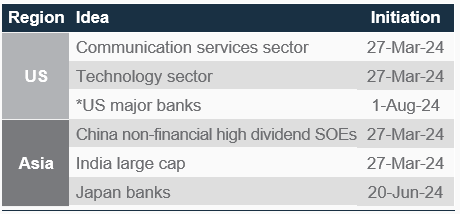
impact over time as investors continue to be attracted to India’s superior growth. A risk is weaker-than-expected growth.
Japan banks: We believe the Bank of Japan’s path towards higher interest rates would support banks’ interest income and increased capital market activities would boost fee income. Banks’ profitability should also improve as unprofitable assets are shed and reinvested into higher profitability businesses. Major banks also have share buyback tailwinds on top of dividend yields of 2.5-3.0%. A slowdown in Japan’s economic recovery is a risk.
Sector views: Growth in technology
While technology in the US and Europe benefits from AI demand and cloud computing, China’s technology sector is seeing strong EM demand for its tech hardware. We also like consumption exposed sectors in China, such as communication services and consumer discretionary.
Fig. 15 Our sector views by region
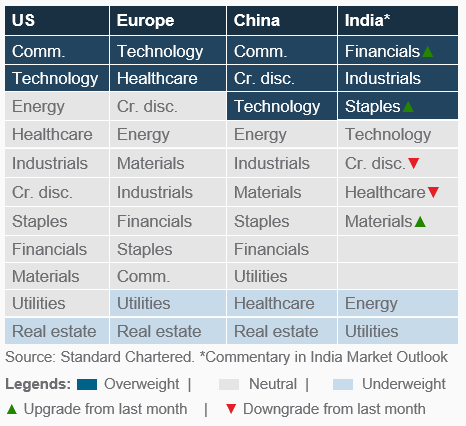
FX – at a glance
|
Key themes
We hold a modestly bearish view on the USD over the next 1-3 months. While US bond yields have started to fall as inflation numbers soften, a further dovish tilt in the Fed’s monetary policy is likely to act as a headwind for the dollar. Meanwhile, the market is closely watching the US election. Historically, policymaker preferences for a strong or weak USD tended to have only a short-term impact, with economic conditions and policy rates being more binding limitations. Therefore, despite Trump’s preference for a softer USD to increase the competitiveness of US manufacturing and exports, we believe the USD will be more rangebound with a bullish bias over 6-12 months once major centrals banks cut rates in lockstep.
EUR/USD is likely to rise towards 1.10 on a 3-month horizon given our view of a softer greenback and further ECB rate cuts. GBP/USD is likely to have a bullish bias over the next 3 months amid political stability and recent economic resilience. Despite the BoE delivering a surprise rate cut in August, BoE Governor Andrew Bailey cautioned that the move would not herald a rapid succession of further cuts. The JPY has the most potential to strengthen further in the short term given continued Bank of Japan efforts to hike rates and reduce monthly bond purchases. However, CAD and CNH weaknesses are likely to continue amid cooling commodity prices and a still soft recovery in China’s economy.
The CHF is likely to consolidate over the next 1-3 months. The Swiss National Bank’s rate cut makes further CHF strength unlikely, though a USD/CHF rebound back to April highs will likely need a fresh catalyst. The AUD is expected to remain well-supported by a relatively more hawkish central bank and gold prices. However, the pressure for RBNZ to cut rates is mounting, likely capping any NZD upside at 0.61.
Key chart
The real rate differentials suggest the USD is at fair value. A further compression of USD’s real interest rate differentials in the mid-to-long term is likely to put downward pressure on the USD.
Fig. 16 Real interest rate differentials suggest the USD is close to fair value
DXY index, DXY-weighted interest rate differentials*; Table of forecasts
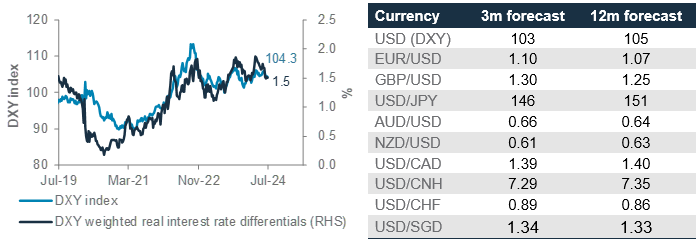
What is the near-term outlook for FX under different US election scenarios?
The upcoming US presidential election has been a key focus. We believe a Republican (Trump) clean-sweep scenario could result in USD gains amid expectations of incrementally higher US yields and greater domestic spending. JPY and CHF may be relatively better-supported than other major currencies in this scenario as investors focus on safe havens amid rising geopolitical risks (especially from Trump’s proposed tariff policy) and the BoJ’s contrasting policy stance.
Conversely, a scenario of a Democrat (Harris) sweep would likely lead to some USD weakness. This is a scenario where
we see policy continuity, leading to the focus returning to Fed rate cuts and a reduced rate advantage for the greenback.
The direction of the USD is less clear if a Democrat or Republican president is challenged by opposing parties in Congress, given this would constrain their ability to set policy freely, particularly on domestic issues. A Trump presidency may still involve more USD demand compared with a Democrat presidency, unless policymakers have greater-than-expected success with proposed ‘weak dollar’ policies. We would maintain a focus on other fundamental drivers, especially Fed rate cuts and what they mean for the USD’s rate differentials.
Gold, crude oil – at a glance
|
Key themes
We bumped up our 3-month gold forecast to USD 2,450/oz on a more dovish Fed. The precious metal rose to a new record high on rising Fed rate cut expectations before consolidating in recent weeks. We believe the latest inflation and growth data will help bring the Fed closer to starting rate cuts, which would bring down the real (net-of-inflation) yield and USD. Gold ETF holdings appear to be bottoming and could rebound once the Fed cuts. While official and consumer demand in China appears to be waning, Indian demand is likely to pick up the slack on lower import and capital gains taxes. In the long run, we maintain a Core Holding view on gold, given the robust official sector demand and physical consumption. We also note that the yellow metal stands to benefit regardless of the US election outcome (read page 8), making it an attractive portfolio ballast.
We expect WTI oil to trade around USD 80/bbl over the next 3 months on a tight near-term demand/supply balance. Crude oil prices were rangebound in early July before coming under pressure on global demand concerns, especially from China. The recent weakness pushed crude oil into oversold territory. We believe the oil markets are still in a deficit this quarter given OPEC+ extended all three rounds of output cuts and still-resilient demand. The inventory draws over the past few weeks suggest that summer demand is still holding up in the US. Moreover, geopolitical tensions pose upside risks to oil prices – we remain on watch for Middle East conflicts and Venezuela election results. In the longer term, the demand-supply dynamics are likely to improve, implying a lower WTI oil price at around USD 75/bbl.
Key chart
It is better to examine the implications through the policies of a specific administration.
Fig. 17 Gold and crude oil historically perform better under a Democratic president though the range of results is wide
LHS chart: Gold performance in past presidential elections (+/- 6 months, whole term)*
RHS chart: Oil performance in historical presidential elections (+/- 6 months, whole term)^

Gold is a Trump trade?
Our analysis reveals that gold tends to do well 6 months before a Republican win and stays sluggish after the election. Conversely, gold generally declines before a Democratic win and rises after election. However, looking under the hood, the range of results is quite wide. Coupled with the small sample sizes for each scenario, there appears to be a lack of evidence to support a strong correlation between gold and the winning party. In our view, a better way to analyse this is through policies of a specific administration and their influence on the key drivers of gold. An additional lens we have this time is the gold performance during Trump’s first term in 2016.
A Trump presidency could provide several tailwinds for gold – growing concern on fiscal debt, tariffs, ensuing geopolitical tensions and high policy uncertainty. While gold fell initially, it went on to rise by almost 50% in Trump’s first term.
Trump 2.0 is marginally bearish for oil
Our analysis shows that crude oil performs better under a Democratic president. However, we note that the result is skewed by the 2020 election, when oil prices were depressed by COVID-19. Similar to gold, there is significant variability within the results. Thus, it is better to examine the implications through the potential policies of Trump. Most Trump policies are bearish crude oil at the margin. He has an intention to deregulate the domestic US oil industry, which would bump up production. His push for a Russia-Ukraine ceasefire and warmer ties with Saudi could also add to supply. Some would argue that there are some offsetting factors. Further sanctions on Iran may not be effective given weak enforcement. There are also talks of Trump unwinding the Inflation Reduction Act, slowing down the transition from crude oil.
Additional perspectives
Quant perspective
Still bullish equities, but higher near-term risks
|
|
||||
Summary
The stock-bond rotation model retains a small Overweight to equities even though fundamentals remain weak. The model recorded a 2.7% outperformance against the 60-40 equity-bond portfolio this year. Since May, the model has reduced its OW to equities as the ISM manufacturing new orders and economic surprise index showed signs of an economic slowdown globally. As net earnings upgrades are cushioning some of these effects, the current US earnings season is crucial as any significant downside surprises in earnings will likely lead to further weakness in fundamentals.
Our technical model remains broadly bullish equities, but near-term risks have risen. The model has recorded an average return of 3.0% across the US, Europe ex-UK, Asia ex-Japan, Japan and China equity indices (USD terms), compared with an average buy-and-hold return of 1.6% across these indices. It continues to favour most equity markets except Japan and China. Near-term risks, however, have risen for the S&P 500 as implied volatility has jumped. For Japan, the model’s bearish view worked out well as the steep rally in Japan equities faded quickly after meeting a strong resistance level. Our model also took profit in China equities in early July as our indicators show the market has reverted into a low-volatility bear market scenario.
Our diversity indicator previously flagged stretched investor positioning in US equities in mid-July. US equities had a pullback when our investor diversity indicator flagged stretched positioning in mid-July. This was timely as it coincided with the rotation out of US tech, which had been a crowded trade. Our diversity indicators have now normalised after the recent pullback, and our technical model above remains positive on equities despite near-term risks.
Key chart
Stock-bond model’s score has fallen to 2 from 4 in April as economic indicators show weakness.
Fig. 18 Breakdown of stock-bond rotation model’s scores since inception in Feb-2023
Model scores as the total of fundamental, valuation and market breadth factors
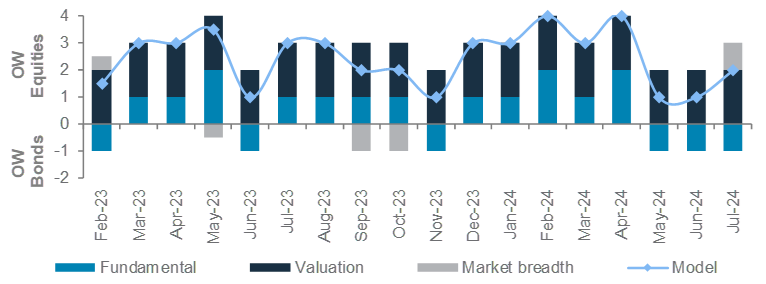
Technical model maintains a bullish view on the S&P 500 but near-term risks have risen as implied volatility increased.
Fig. 19 Technical model remains bullish S&P 500
S&P 500 continues to trade above its price channel

Fig. 20 Long- and short-term quantitative models are bullish risky assets
Long-term models below have a typical time horizon of 3–6 months, while short-term models have 1– 3 months horizon
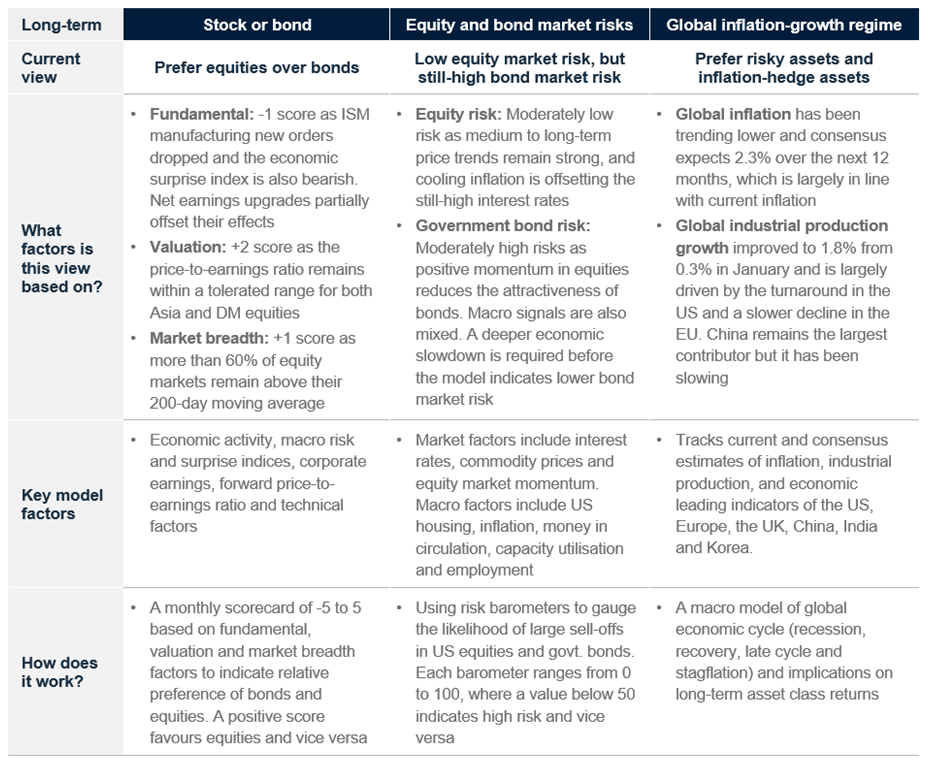
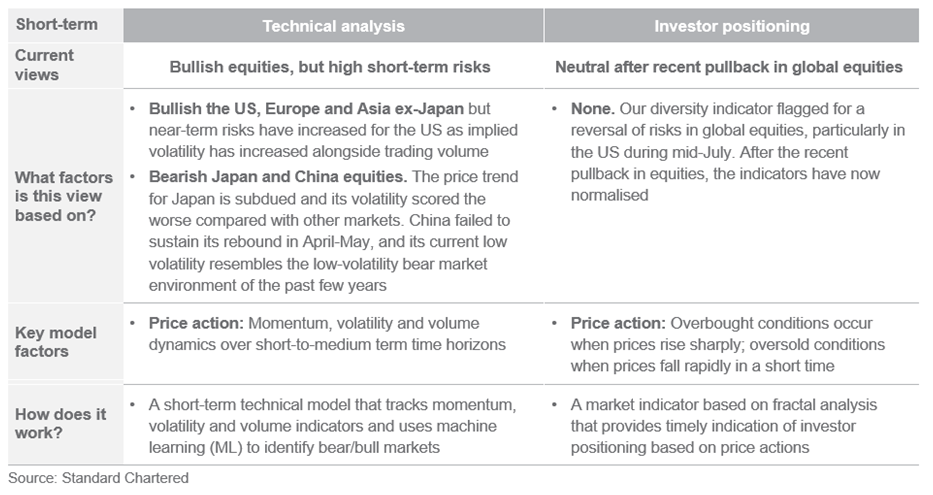
Today, Tomorrow and Forever

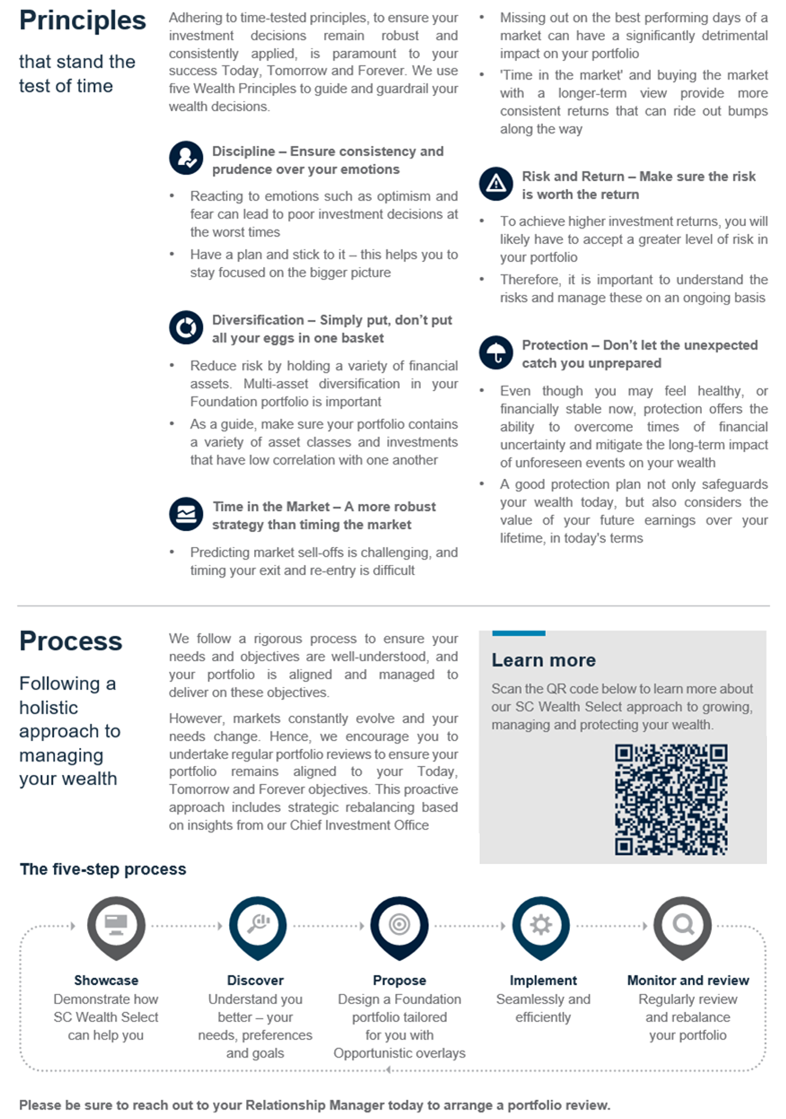
Performance Review
Foundation: Asset allocation summary
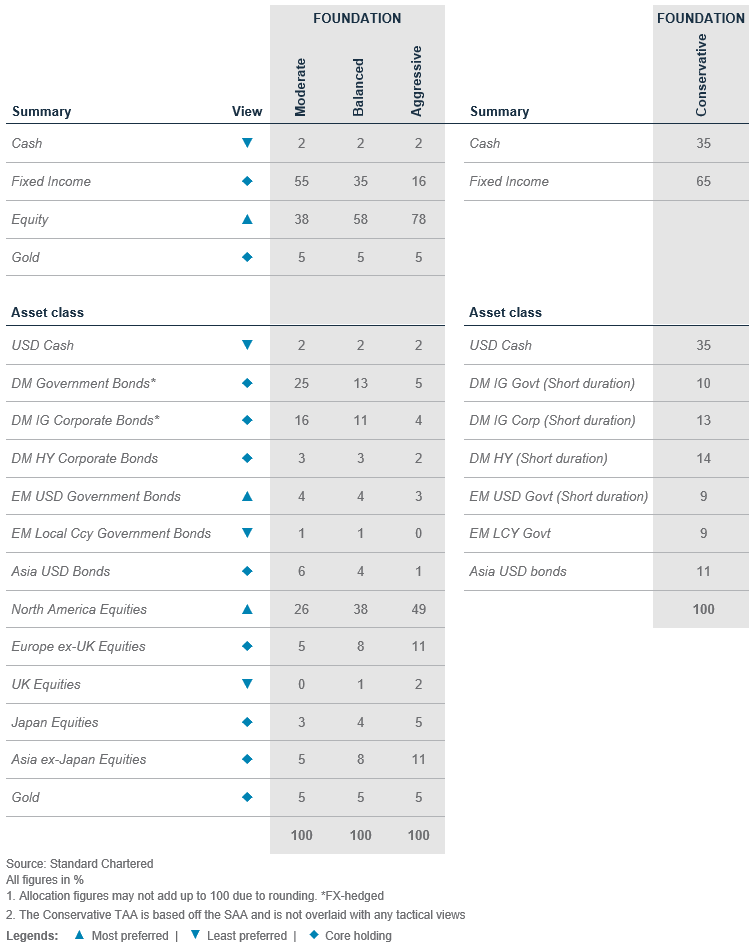
Foundation+: Asset allocation summary

Market performance summary
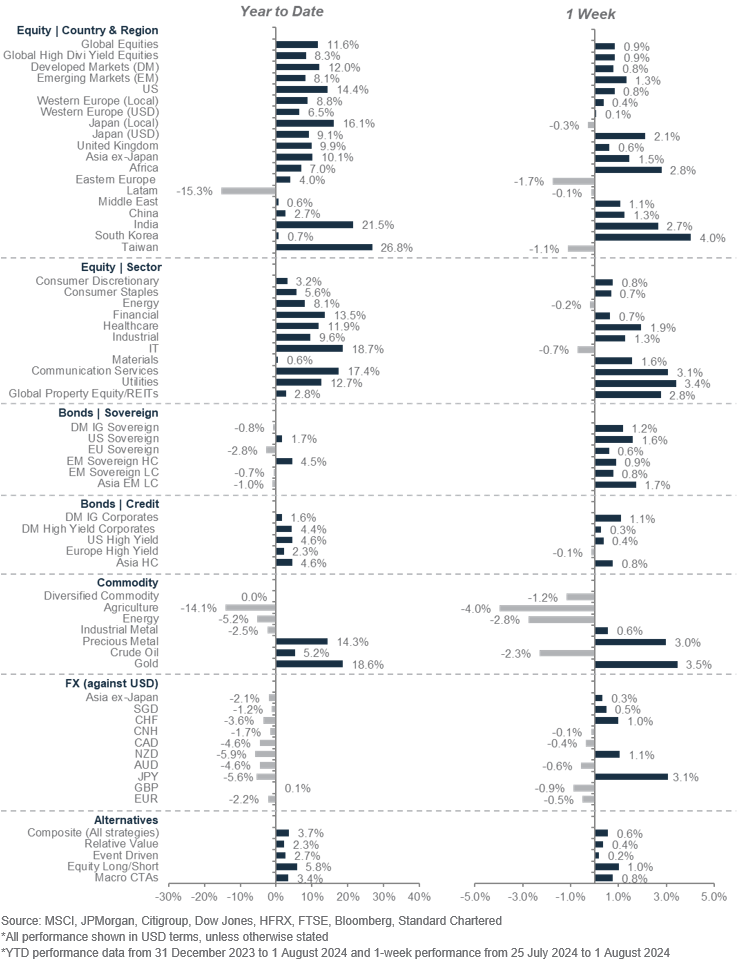
Our key forecasts and calendar events

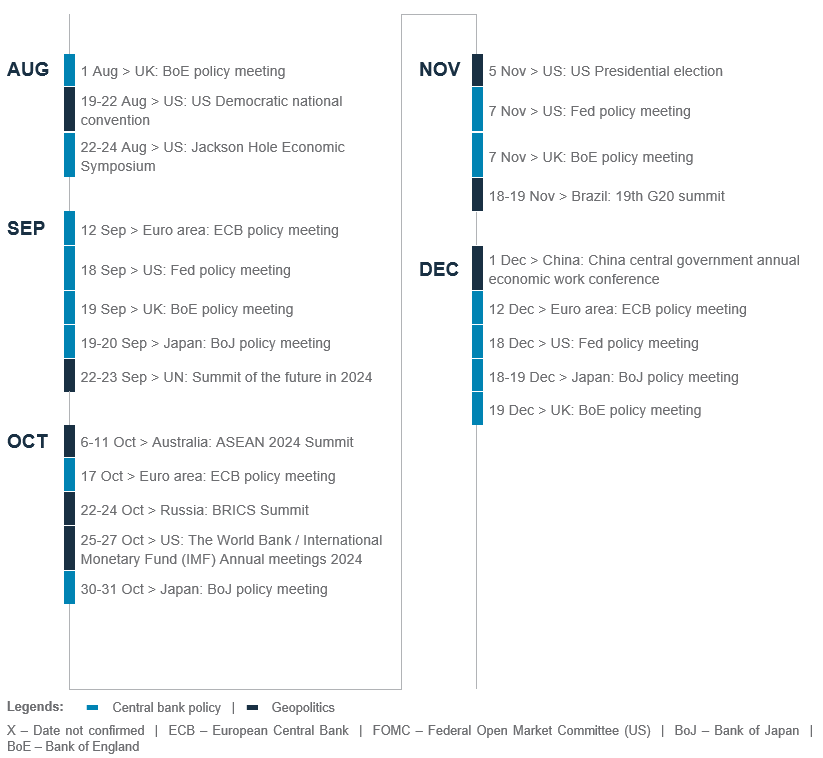
For more CIO Office insights

Explanatory notes
1. The figures on page 5 show allocations for a moderately aggressive risk profile only – different risk profiles may produce significantly different asset allocation results. Page 5 is only an example, provided for general information only and they do not constitute investment advice, an offer, recommendation or solicitation. They do not take into account the specific investment objectives, needs or risk tolerances of a particular person or class of persons and they have not been prepared for any particular person or class of persons.
2. Contingent Convertibles are complex financial instruments and are not a suitable or appropriate investment for all investors. This document is not an offer to sell or an invitation to buy any securities or any beneficial interests therein. Contingent convertible securities are not intended to be sold and should not be sold to retail clients in the European Economic Area (EEA) (each as defined in the Policy Statement on the Restrictions on the Retail Distribution of Regulatory Capital Instruments (Feedback to CP14/23 and Final Rules) (“Policy Statement”), read together with the Product Intervention (Contingent Convertible Instruments and Mutual Society Shares) Instrument 2015 (“Instrument”, and together with the Policy Statement, the “Permanent Marketing Restrictions”), which were published by the United Kingdom’s Financial Conduct Authority in June 2015), other than in circumstances that do not give rise to a contravention of the Permanent Marketing Restrictions.
Disclosure
This document is confidential and may also be privileged. If you are not the intended recipient, please destroy all copies and notify the sender immediately. This document is being distributed for general information only and is subject to the relevant disclaimers available at our Standard Chartered website under Regulatory disclosures. It is not and does not constitute research material, independent research, an offer, recommendation or solicitation to enter into any transaction or adopt any hedging, trading or investment strategy, in relation to any securities or other financial instruments. This document is for general evaluation only. It does not take into account the specific investment objectives, financial situation or particular needs of any particular person or class of persons and it has not been prepared for any particular person or class of persons. You should not rely on any contents of this document in making any investment decisions. Before making any investment, you should carefully read the relevant offering documents and seek independent legal, tax and regulatory advice. In particular, we recommend you to seek advice regarding the suitability of the investment product, taking into account your specific investment objectives, financial situation or particular needs, before you make a commitment to purchase the investment product. Opinions, projections and estimates are solely those of SC at the date of this document and subject to change without notice. Past performance is not indicative of future results and no representation or warranty is made regarding future performance. The value of investments, and the income from them, can go down as well as up, and you may not recover the amount of your original investment. You are not certain to make a profit and may lose money. Any forecast contained herein as to likely future movements in rates or prices or likely future events or occurrences constitutes an opinion only and is not indicative of actual future movements in rates or prices or actual future events or occurrences (as the case may be). This document must not be forwarded or otherwise made available to any other person without the express written consent of the Standard Chartered Group (as defined below). Standard Chartered Bank is incorporated in England with limited liability by Royal Charter 1853 Reference Number ZC18. The Principal Office of the Company is situated in England at 1 Basinghall Avenue, London, EC2V 5DD. Standard Chartered Bank is authorised by the Prudential Regulation Authority and regulated by the Financial Conduct Authority and Prudential Regulation Authority. Standard Chartered PLC, the ultimate parent company of Standard Chartered Bank, together with its subsidiaries and affiliates (including each branch or representative office), form the Standard Chartered Group. Standard Chartered Private Bank is the private banking division of Standard Chartered. Private banking activities may be carried out internationally by different legal entities and affiliates within the Standard Chartered Group (each an “SC Group Entity”) according to local regulatory requirements. Not all products and services are provided by all branches, subsidiaries and affiliates within the Standard Chartered Group. Some of the SC Group Entities only act as representatives of Standard Chartered Private Bank and may not be able to offer products and services or offer advice to clients.
Copyright © 2025, Accounting Research & Analytics, LLC d/b/a CFRA (and its affiliates, as applicable). Reproduction of content provided by CFRA in any form is prohibited except with the prior written permission of CFRA. CFRA content is not investment advice and a reference to or observation concerning a security or investment provided in the CFRA SERVICES is not a recommendation to buy, sell or hold such investment or security or make any other investment decisions. The CFRA content contains opinions of CFRA based upon publicly-available information that CFRA believes to be reliable and the opinions are subject to change without notice. This analysis has not been submitted to, nor received approval from, the United States Securities and Exchange Commission or any other regulatory body. While CFRA exercised due care in compiling this analysis, CFRA, ITS THIRD-PARTY SUPPLIERS, AND ALL RELATED ENTITIES SPECIFICALLY DISCLAIM ALL WARRANTIES, EXPRESS OR IMPLIED, INCLUDING, BUT NOT LIMITED TO, ANY WARRANTIES OF MERCHANTABILITY OR FITNESS FOR A PARTICULAR PURPOSE OR USE, to the full extent permitted by law, regarding the accuracy, completeness, or usefulness of this information and assumes no liability with respect to the consequences of relying on this information for investment or other purposes. No content provided by CFRA (including ratings, credit-related analyses and data, valuations, model, software or other application or output therefrom) or any part thereof may be modified, reverse engineered, reproduced or distributed in any form by any means, or stored in a database or retrieval system, without the prior written permission of CFRA, and such content shall not be used for any unlawful or unauthorized purposes. CFRA and any third-party providers, as well as their directors, officers, shareholders, employees or agents do not guarantee the accuracy, completeness, timeliness or availability of such content. In no event shall CFRA, its affiliates, or their third-party suppliers be liable for any direct, indirect, special, or consequential damages, costs, expenses, legal fees, or losses (including lost income or lost profit and opportunity costs) in connection with a subscriber’s, subscriber’s customer’s, or other’s use of CFRA’s content.
Market Abuse Regulation (MAR) Disclaimer
Banking activities may be carried out internationally by different branches, subsidiaries and affiliates within the Standard Chartered Group according to local regulatory requirements. Opinions may contain outright “buy”, “sell”, “hold” or other opinions. The time horizon of this opinion is dependent on prevailing market conditions and there is no planned frequency for updates to the opinion. This opinion is not independent of Standard Chartered Group’s trading strategies or positions. Standard Chartered Group and/or its affiliates or its respective officers, directors, employee benefit programmes or employees, including persons involved in the preparation or issuance of this document may at any time, to the extent permitted by applicable law and/or regulation, be long or short any securities or financial instruments referred to in this document or have material interest in any such securities or related investments. Therefore, it is possible, and you should assume, that Standard Chartered Group has a material interest in one or more of the financial instruments mentioned herein. Please refer to our Standard Chartered website under Regulatory disclosures for more detailed disclosures, including past opinions/ recommendations in the last 12 months and conflict of interests, as well as disclaimers. A covering strategist may have a financial interest in the debt or equity securities of this company/issuer. All covering strategist are licensed to provide investment recommendations under Monetary Authority of Singapore or Hong Kong Monetary Authority. This document must not be forwarded or otherwise made available to any other person without the express written consent of Standard Chartered Group.
Sustainable Investments
Any ESG data used or referred to has been provided by Morningstar, Sustainalytics, MSCI or Bloomberg. Refer to 1) Morningstar website under Sustainable Investing, 2) Sustainalytics website under ESG Risk Ratings, 3) MCSI website under ESG Business Involvement Screening Research and 4) Bloomberg green, social & sustainability bonds guide for more information. The ESG data is as at the date of publication based on data provided, is for informational purpose only and is not warranted to be complete, timely, accurate or suitable for a particular purpose, and it may be subject to change. Sustainable Investments (SI): This refers to funds that have been classified as ‘ESG Intentional Investments – Overall’ by Morningstar. SI funds have explicitly stated in their prospectus and regulatory filings that they either incorporate ESG factors into the investment process or have a thematic focus on the environment, gender diversity, low carbon, renewable energy, water or community development. For equity, it refers to shares/stocks issued by companies with Sustainalytics ESG Risk Rating of Low/Negligible. For bonds, it refers to debt instruments issued by issuers with Sustainalytics ESG Risk Rating of Low/Negligible, and/or those being certified green, social, sustainable bonds by Bloomberg. For structured products, it refers to products that are issued by any issuer who has a Sustainable Finance framework that aligns with Standard Chartered’s Green and Sustainable Product Framework, with underlying assets that are part of the Sustainable Investment universe or separately approved by Standard Chartered’s Sustainable Finance Governance Committee. Sustainalytics ESG risk ratings shown are factual and are not an indicator that the product is classified or marketed as “green”, “sustainable” or similar under any particular classification system or framework.
Country/Market Specific Disclosures
Bahrain: This document is being distributed in Bahrain by Standard Chartered Bank, Bahrain Branch, having its address at P.O. 29, Manama, Kingdom of Bahrain, is a branch of Standard Chartered Bank and is licensed by the Central Bank of Bahrain as a conventional retail bank. Botswana: This document is being distributed in Botswana by, and is attributable to, Standard Chartered Bank Botswana Limited which is a financial institution licensed under the Section 6 of the Banking Act CAP 46.04 and is listed in the Botswana Stock Exchange. Brunei Darussalam: This document is being distributed in Brunei Darussalam by, and is attributable to, Standard Chartered Bank (Brunei Branch) | Registration Number RFC/61 and Standard Chartered Securities (B) Sdn Bhd | Registration Number RC20001003. Standard Chartered Bank is incorporated in England with limited liability by Royal Charter 1853 Reference Number ZC18. Standard Chartered Securities (B) Sdn Bhd is a limited liability company registered with the Registry of Companies with Registration Number RC20001003 and licensed by Brunei Darussalam Central Bank as a Capital Markets Service License Holder with License Number BDCB/R/CMU/S3-CL and it is authorised to conduct Islamic investment business through an Islamic window. China Mainland: This document is being distributed in China by, and is attributable to, Standard Chartered Bank (China) Limited which is mainly regulated by National Financial Regulatory Administration (NFRA), State Administration of Foreign Exchange (SAFE), and People’s Bank of China (PBOC). Hong Kong: In Hong Kong, this document, except for any portion advising on or facilitating any decision on futures contracts trading, is distributed by Standard Chartered Bank (Hong Kong) Limited (“SCBHK”), a subsidiary of Standard Chartered PLC. SCBHK has its registered address at 32/F, Standard Chartered Bank Building, 4-4A Des Voeux Road Central, Hong Kong and is regulated by the Hong Kong Monetary Authority and registered with the Securities and Futures Commission (“SFC”) to carry on Type 1 (dealing in securities), Type 4 (advising on securities), Type 6 (advising on corporate finance) and Type 9 (asset management) regulated activity under the Securities and Futures Ordinance (Cap. 571) (“SFO”) (CE No. AJI614). The contents of this document have not been reviewed by any regulatory authority in Hong Kong and you are advised to exercise caution in relation to any offer set out herein. If you are in doubt about any of the contents of this document, you should obtain independent professional advice. Any product named herein may not be offered or sold in Hong Kong by means of any document at any time other than to “professional investors” as defined in the SFO and any rules made under that ordinance. In addition, this document may not be issued or possessed for the purposes of issue, whether in Hong Kong or elsewhere, and any interests may not be disposed of, to any person unless such person is outside Hong Kong or is a “professional investor” as defined in the SFO and any rules made under that ordinance, or as otherwise may be permitted by that ordinance. In Hong Kong, Standard Chartered Private Bank is the private banking division of SCBHK, a subsidiary of Standard Chartered PLC. Ghana: Standard Chartered Bank Ghana Limited accepts no liability and will not be liable for any loss or damage arising directly or indirectly (including special, incidental or consequential loss or damage) from your use of these documents. Past performance is not indicative of future results and no representation or warranty is made regarding future performance. You should seek advice from a financial adviser on the suitability of an investment for you, taking into account these factors before making a commitment to invest in an investment. To unsubscribe from receiving further updates, please send an email to feedback.ghana@sc.com. Please do not reply to this email. Call our Priority Banking on 0302610750 for any questions or service queries. You are advised not to send any confidential and/or important information to Standard Chartered via e-mail, as Standard Chartered makes no representations or warranties as to the security or accuracy of any information transmitted via e-mail. Standard Chartered shall not be responsible for any loss or damage suffered by you arising from your decision to use e-mail to communicate with the Bank. India: This document is being distributed in India by Standard Chartered in its capacity as a distributor of mutual funds and referrer of any other third party financial products. Standard Chartered does not offer any ‘Investment Advice’ as defined in the Securities and Exchange Board of India (Investment Advisers) Regulations, 2013 or otherwise. Services/products related securities business offered by Standard Charted are not intended for any person, who is a resident of any jurisdiction, the laws of which imposes prohibition on soliciting the securities business in that jurisdiction without going through the registration requirements and/or prohibit the use of any information contained in this document. Indonesia: This document is being distributed in Indonesia by Standard Chartered Bank, Indonesia branch, which is a financial institution licensed and supervised by Otoritas Jasa Keuangan (Financial Service Authority) and Bank Indonesia. Jersey: In Jersey, Standard Chartered Private Bank is the Registered Business Name of the Jersey Branch of Standard Chartered Bank. The Jersey Branch of Standard Chartered Bank is regulated by the Jersey Financial Services Commission. Copies of the latest audited accounts of Standard Chartered Bank are available from its principal place of business in Jersey: PO Box 80, 15 Castle Street, St Helier, Jersey JE4 8PT. Standard Chartered Bank is incorporated in England with limited liability by Royal Charter in 1853 Reference Number ZC 18. The Principal Office of the Company is situated in England at 1 Basinghall Avenue, London, EC2V 5DD. Standard Chartered Bank is authorised by the Prudential Regulation Authority and regulated by the Financial Conduct Authority and Prudential Regulation Authority. The Jersey Branch of Standard Chartered Bank is also an authorised financial services provider under license number 44946 issued by the Financial Sector Conduct Authority of the Republic of South Africa. Jersey is not part of the United Kingdom and all business transacted with Standard Chartered Bank, Jersey Branch and other SC Group Entity outside of the United Kingdom, are not subject to some or any of the investor protection and compensation schemes available under United Kingdom law. Kenya: This document is being distributed in Kenya by and is attributable to Standard Chartered Bank Kenya Limited. Investment Products and Services are distributed by Standard Chartered Investment Services Limited, a wholly owned subsidiary of Standard Chartered Bank Kenya Limited that is licensed by the Capital Markets Authority in Kenya, as a Fund Manager. Standard Chartered Bank Kenya Limited is regulated by the Central Bank of Kenya. Malaysia: This document is being distributed in Malaysia by Standard Chartered Bank Malaysia Berhad (“SCBMB”). Recipients in Malaysia should contact SCBMB in relation to any matters arising from, or in connection with, this document. This document has not been reviewed by the Securities Commission Malaysia. The product lodgement, registration, submission or approval by the Securities Commission of Malaysia does not amount to nor indicate recommendation or endorsement of the product, service or promotional activity. Investment products are not deposits and are not obligations of, not guaranteed by, and not protected by SCBMB or any of the affiliates or subsidiaries, or by Perbadanan Insurans Deposit Malaysia, any government or insurance agency. Investment products are subject to investment risks, including the possible loss of the principal amount invested. SCBMB expressly disclaim any liability and responsibility for any loss arising directly or indirectly (including special, incidental or consequential loss or damage) arising from the financial losses of the Investment Products due to market condition. Nigeria: This document is being distributed in Nigeria by Standard Chartered Bank Nigeria Limited (SCB Nigeria), a bank duly licensed and regulated by the Central Bank of Nigeria. SCB Nigeria accepts no liability for any loss or damage arising directly or indirectly (including special, incidental or consequential loss or damage) from your use of these documents. You should seek advice from a financial adviser on the suitability of an investment for you, taking into account these factors before making a commitment to invest in an investment. To unsubscribe from receiving further updates, please send an email to clientcare.ng@sc.com requesting to be removed from our mailing list. Please do not reply to this email. Call our Priority Banking on 02 012772514 for any questions or service queries. SCB Nigeria shall not be responsible for any loss or damage arising from your decision to send confidential and/or important information to Standard Chartered via e-mail. SCB Nigeria makes no representations or warranties as to the security or accuracy of any information transmitted via e-mail. Pakistan: This document is being distributed in Pakistan by, and attributable to Standard Chartered Bank (Pakistan) Limited having its registered office at PO Box 5556, I.I Chundrigar Road Karachi, which is a banking company registered with State Bank of Pakistan under Banking Companies Ordinance 1962 and is also having licensed issued by Securities & Exchange Commission of Pakistan for Security Advisors. Standard Chartered Bank (Pakistan) Limited acts as a distributor of mutual funds and referrer of other third-party financial products. Singapore: This document is being distributed in Singapore by, and is attributable to, Standard Chartered Bank (Singapore) Limited (Registration No. 201224747C/ GST Group Registration No. MR-8500053-0, “SCBSL”). Recipients in Singapore should contact SCBSL in relation to any matters arising from, or in connection with, this document. SCBSL is an indirect wholly owned subsidiary of Standard Chartered Bank and is licensed to conduct banking business in Singapore under the Singapore Banking Act, 1970. Standard Chartered Private Bank is the private banking division of SCBSL. IN RELATION TO ANY SECURITY OR SECURITIES-BASED DERIVATIVES CONTRACT REFERRED TO IN THIS DOCUMENT, THIS DOCUMENT, TOGETHER WITH THE ISSUER DOCUMENTATION, SHALL BE DEEMED AN INFORMATION MEMORANDUM (AS DEFINED IN SECTION 275 OF THE SECURITIES AND FUTURES ACT, 2001 (“SFA”)). THIS DOCUMENT IS INTENDED FOR DISTRIBUTION TO ACCREDITED INVESTORS, AS DEFINED IN SECTION 4A(1)(a) OF THE SFA, OR ON THE BASIS THAT THE SECURITY OR SECURITIES-BASED DERIVATIVES CONTRACT MAY ONLY BE ACQUIRED AT A CONSIDERATION OF NOT LESS THAN S$200,000 (OR ITS EQUIVALENT IN A FOREIGN CURRENCY) FOR EACH TRANSACTION. Further, in relation to any security or securities-based derivatives contract, neither this document nor the Issuer Documentation has been registered as a prospectus with the Monetary Authority of Singapore under the SFA. Accordingly, this document and any other document or material in connection with the offer or sale, or invitation for subscription or purchase, of the product may not be circulated or distributed, nor may the product be offered or sold, or be made the subject of an invitation for subscription or purchase, whether directly or indirectly, to persons other than a relevant person pursuant to section 275(1) of the SFA, or any person pursuant to section 275(1A) of the SFA, and in accordance with the conditions specified in section 275 of the SFA, or pursuant to, and in accordance with the conditions of, any other applicable provision of the SFA. In relation to any collective investment schemes referred to in this document, this document is for general information purposes only and is not an offering document or prospectus (as defined in the SFA). This document is not, nor is it intended to be (i) an offer or solicitation of an offer to buy or sell any capital markets product; or (ii) an advertisement of an offer or intended offer of any capital markets product. Deposit Insurance Scheme: Singapore dollar deposits of non-bank depositors are insured by the Singapore Deposit Insurance Corporation, for up to S$100,000 in aggregate per depositor per Scheme member by law. Foreign currency deposits, dual currency investments, structured deposits and other investment products are not insured. This advertisement has not been reviewed by the Monetary Authority of Singapore. Taiwan: SC Group Entity or Standard Chartered Bank (Taiwan) Limited (“SCB (Taiwan)”) may be involved in the financial instruments contained herein or other related financial instruments. The author of this document may have discussed the information contained herein with other employees or agents of SC or SCB (Taiwan). The author and the above-mentioned employees of SC or SCB (Taiwan) may have taken related actions in respect of the information involved (including communication with customers of SC or SCB (Taiwan) as to the information contained herein). The opinions contained in this document may change, or differ from the opinions of employees of SC or SCB (Taiwan). SC and SCB (Taiwan) will not provide any notice of any changes to or differences between the above-mentioned opinions. This document may cover companies with which SC or SCB (Taiwan) seeks to do business at times and issuers of financial instruments. Therefore, investors should understand that the information contained herein may serve as specific purposes as a result of conflict of interests of SC or SCB (Taiwan). SC, SCB (Taiwan), the employees (including those who have discussions with the author) or customers of SC or SCB (Taiwan) may have an interest in the products, related financial instruments or related derivative financial products contained herein; invest in those products at various prices and on different market conditions; have different or conflicting interests in those products. The potential impacts include market makers’ related activities, such as dealing, investment, acting as agents, or performing financial or consulting services in relation to any of the products referred to in this document. UAE: DIFC – Standard Chartered Bank is incorporated in England with limited liability by Royal Charter 1853 Reference Number ZC18.The Principal Office of the Company is situated in England at 1 Basinghall Avenue, London, EC2V 5DD. Standard Chartered Bank is authorised by the Prudential Regulation Authority and regulated by the Financial Conduct Authority and Prudential Regulation Authority. Standard Chartered Bank, Dubai International Financial Centre having its offices at Dubai International Financial Centre, Building 1, Gate Precinct, P.O. Box 999, Dubai, UAE is a branch of Standard Chartered Bank and is regulated by the Dubai Financial Services Authority (“DFSA”). This document is intended for use only by Professional Clients and is not directed at Retail Clients as defined by the DFSA Rulebook. In the DIFC we are authorised to provide financial services only to clients who qualify as Professional Clients and Market Counterparties and not to Retail Clients. As a Professional Client you will not be given the higher retail client protection and compensation rights and if you use your right to be classified as a Retail Client we will be unable to provide financial services and products to you as we do not hold the required license to undertake such activities. For Islamic transactions, we are acting under the supervision of our Shariah Supervisory Committee. Relevant information on our Shariah Supervisory Committee is currently available on the Standard Chartered Bank website in the Islamic banking section. For residents of the UAE – Standard Chartered UAE (“SC UAE”) is licensed by the Central Bank of the U.A.E. SC UAE is licensed by Securities and Commodities Authority to practice Promotion Activity. SC UAE does not provide financial analysis or consultation services in or into the UAE within the meaning of UAE Securities and Commodities Authority Decision No. 48/r of 2008 concerning financial consultation and financial analysis. Uganda: Our Investment products and services are distributed by Standard Chartered Bank Uganda Limited, which is licensed by the Capital Markets Authority as an investment adviser. United Kingdom: In the UK, Standard Chartered Bank is authorised by the Prudential Regulation Authority and regulated by the Financial Conduct Authority and Prudential Regulation Authority. This communication has been approved by Standard Chartered Bank for the purposes of Section 21 (2) (b) of the United Kingdom’s Financial Services and Markets Act 2000 (“FSMA”) as amended in 2010 and 2012 only. Standard Chartered Bank (trading as Standard Chartered Private Bank) is also an authorised financial services provider (license number 45747) in terms of the South African Financial Advisory and Intermediary Services Act, 2002. The Materials have not been prepared in accordance with UK legal requirements designed to promote the independence of investment research, and that it is not subject to any prohibition on dealing ahead of the dissemination of investment research. Vietnam: This document is being distributed in Vietnam by, and is attributable to, Standard Chartered Bank (Vietnam) Limited which is mainly regulated by State Bank of Vietnam (SBV). Recipients in Vietnam should contact Standard Chartered Bank (Vietnam) Limited for any queries regarding any content of this document. Zambia: This document is distributed by Standard Chartered Bank Zambia Plc, a company incorporated in Zambia and registered as a commercial bank and licensed by the Bank of Zambia under the Banking and Financial Services Act Chapter 387 of the Laws of Zambia.
